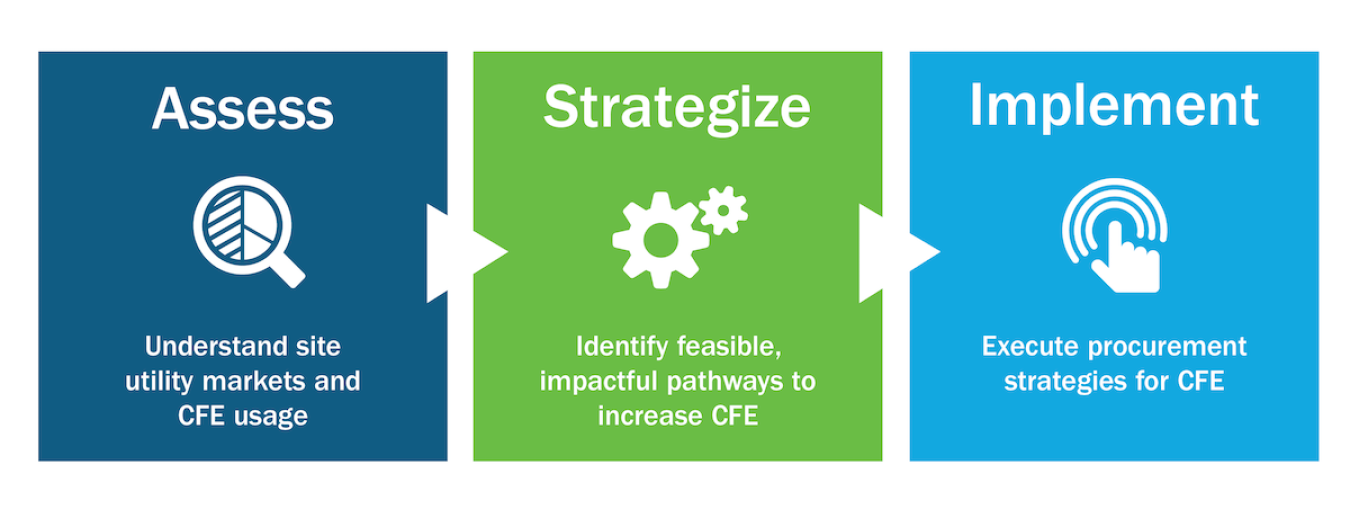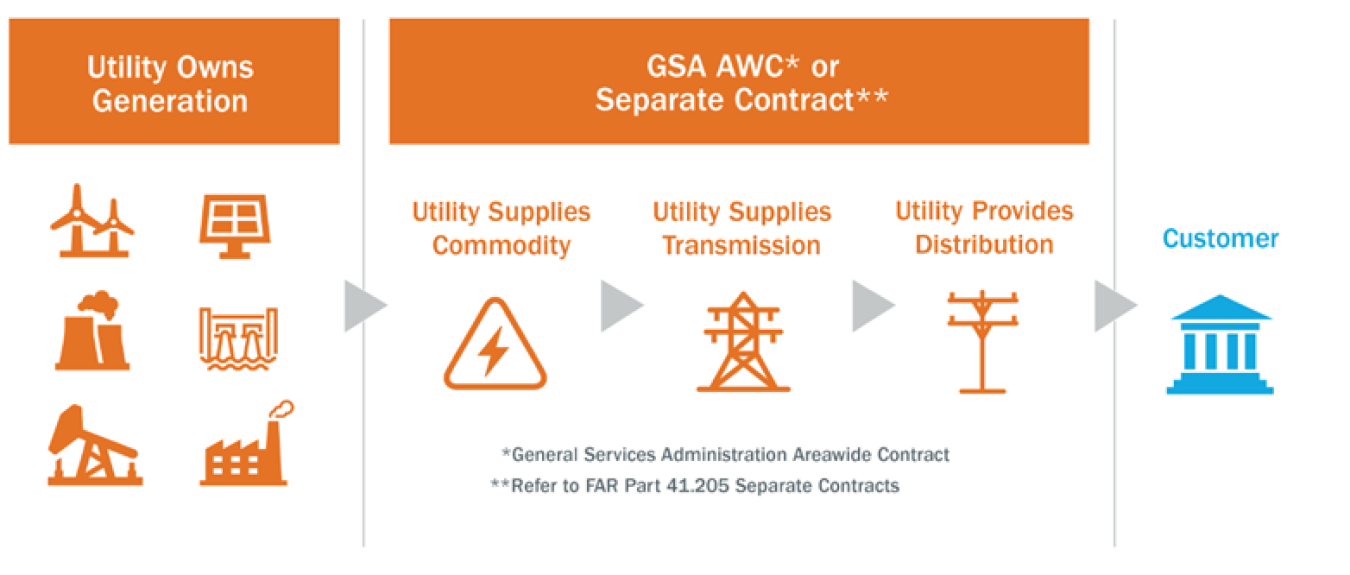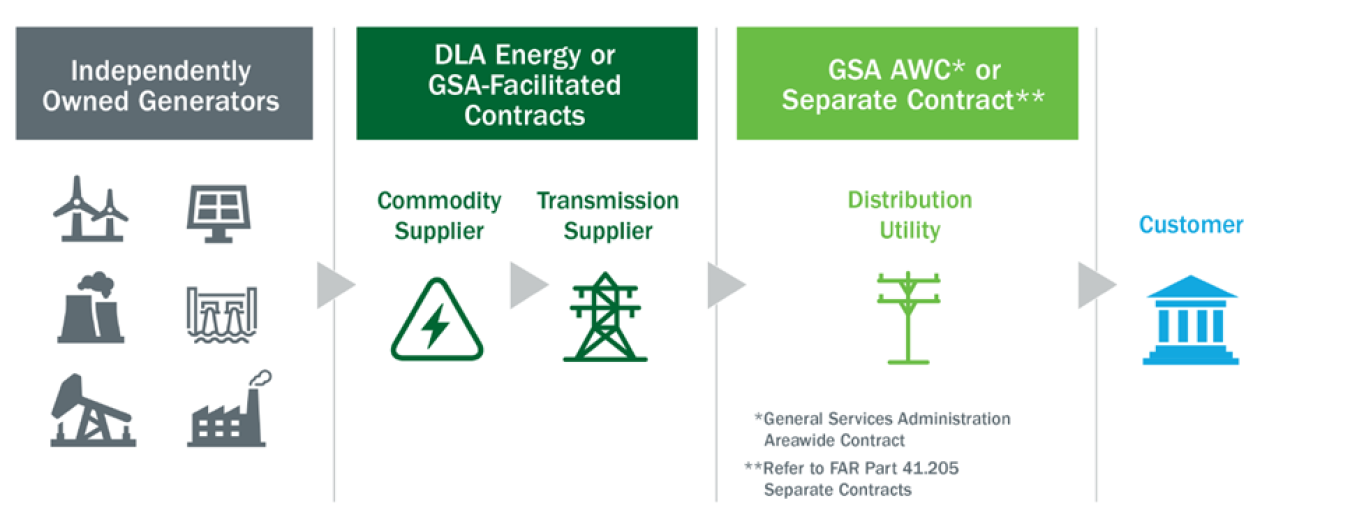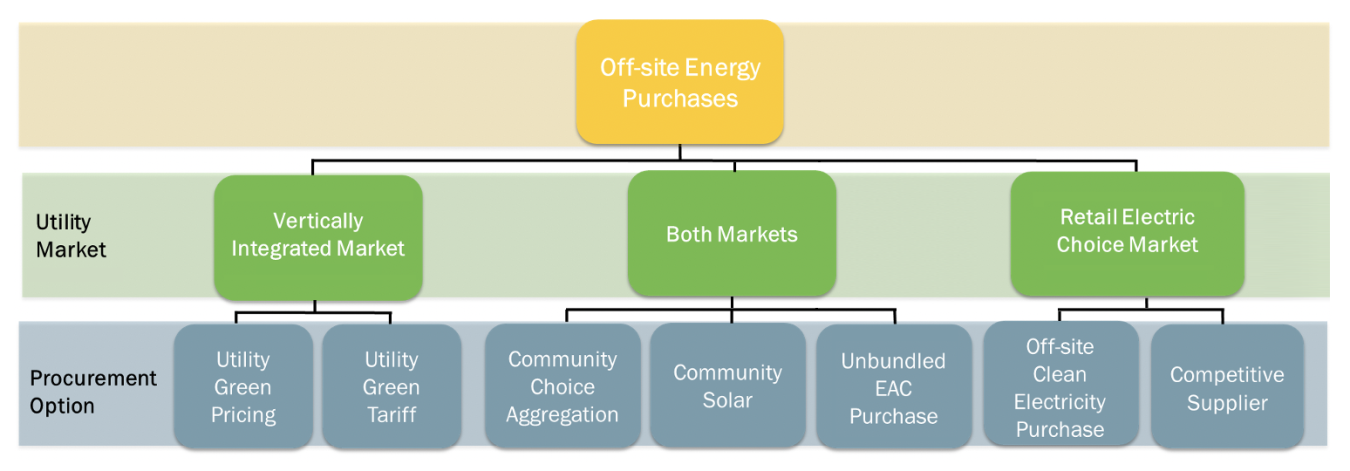This page connects federal agencies to Federal Energy Management Program (FEMP) carbon pollution-free electricity (CFE) resources and provides information to increase federal agency understanding of on-site and off-site CFE options. Additionally, the steps outlined below represent a comprehensive approach to CFE planning and procurement.

Assess
Assess the options available to your site based on the utility regulatory environment in which it is located. Available options will differ depending upon the market structure.
Have a question?
Visit the FEMP Assistance Request Portal for general questions.
For questions in retail electric choice markets:
Utility regulatory markets in the United States are typically determined at the state level and generally fall into one of two types: (1) vertically integrated markets (sometimes referred to as "regulated markets"), and (2) retail electric choice markets (sometimes referred to as "deregulated markets" or "competitive markets").
The CFE procurement options for these market types differ and will be discussed in detail under the Strategize section, below. Figures 1 and 2 illustrate the differences between the market structures.
In vertically integrated markets, the serving utility is responsible for generation, transmission, and distribution of electricity. Customers receive all services including commodity electricity from their serving utility. A site's serving utility is determined by its geographic location.

Figure 1. Vertically integrated market overview.
Exception: Electric cooperatives and municipalities are generally structured as vertically integrated providers.
In retail electric choice markets, customers can choose their electricity supplier and work with GSA or DLA Energy for their commodity electricity purchases, which will be aggregated with other federal loads.
The following states have either complete or partial retail electric choice: California*, Connecticut, Delaware, Illinois*, Maine, Maryland, Massachusetts, Michigan, New Hampshire, New Jersey, New York, Ohio, Oregon, Pennsylvania, Rhode Island, Texas*, Virginia*, and Washington, D.C.
*Electric choice may not be available in all parts of the state or for all customers.

Figure 2. Retail electric choice market overview.
ACTION: Categorize sites based on the regulatory market in which they are located (e.g., retail electric choice, vertically integrated). Because individual states regulate electric utility purchases and sales within their borders, the rules and options regarding the purchase of electricity will vary depending upon a site’s geographic location.
The electricity supply and demand must be balanced at all times for the electric grid to function properly and avoid blackouts. Within the United States, 66 balancing authorities play the key role of maintaining balance between electricity supply and demand within specific geographic regions. Some of these balancing authorities are individual utilities while others are larger regional transmission organizations that balance loads in areas that encompass multiple states.
As facilities consider strategies for increasing off-site CFE procurement, they may wish to prioritize CFE generators that are relatively local to the facility, such as sources that can deliver CFE directly to the balancing area where the facility is located.
Identify the balancing area of your facility by entering its zip code.
Leverage existing information on identified energy conservation measures (ECMs) to project estimated reductions in load. Consider deep energy retrofits and projects funded through performance contracting options such as energy saving performance contracts (ESPCs) and utility energy service contracts (UESCs).
Reminder: Fleet electrification, data centers, and supercomputers will increase your load.
Project future electricity load for each site. This is particularly important when there are plans for a significant increase or decrease in annual electricity consumption due to changes in facility usage or mission, for example. For sites planning to increase their electric vehicle fleet, the EV U-Finder resource can help federal agencies locate which utilities are operating in a specific zip code and which incentives are offered by those utilities.
Strategize
Identify feasible, impactful pathways to increase CFE.
On-Site CFE Projects
Inventory
Take an inventory of available information related to on-site CFE.
- Do your sites have available real property that could be used to site CFE generation (e.g., rooftop, parking structures, adjoining land)?
- Agencies seeking to develop government-owned on-site CFE projects:
- If appropriations are available for the installation of on-site CFE generation projects:
- Leverage available FEMP resources to support your efforts. Utility regulations can be complex, and FEMP can help you navigate the options.
- If appropriations are not available for the installation of on-site CFE generation projects:
- Determine if a comprehensive performance contract project that includes CFE generation is feasible for your site. Leverage FEMP resources regarding third-party financing for on-site distributed energy projects (e.g., ESPC, UESC). Ensure the project is comprehensive and includes energy and water efficiency measures in addition to CFE generation.
- If appropriations are available for the installation of on-site CFE generation projects:
- Agencies seeking to develop third-party owned on-site CFE projects:
- Would your Agency consider hosting utility- or privately-owned CFE generation on your land? Refer to the Annual Energy Management Data Reporting guidance for information regarding third-party owned on-site generation that is consumed by the site.
Reminder: Consider interconnection requirements early in the project development process and refer to the Distributed Energy Interconnection Checklist.
FEMP Resources
Refer to the following FEMP resources for more information and technical assistance.
- REopt: Renewable Energy Integration and Optimization: Techno-economic decision support platform to evaluate the economic viability of distributed energy technologies (e.g., PV, wind, battery storage, geothermal heat pumps) at each site
- Process for Planning and Implementing Federal Distributed Energy Projects: Six phase process to implement distributed energy projects
- Distributed Energy Interconnection Checklist: Series of questions and tasks for agencies to ask their utility, broken out by each interconnection process step
- AFFECT: Assisting Federal Facilities with Energy Conservation Technologies: Funding opportunity through FEMP to meet energy-related goals.
Performance Contracting Options
Performance contracts are a useful strategy for installing energy conservation measures that increase energy and water efficiency as well as installing CFE projects at federal sites without upfront capital funding.
The Energy Act of 2020 amended 42 U.S.C. § 8253(f)(4) to include a new requirement for federal agencies to implement all life-cycle cost-effective energy- or water-saving measures identified in a federal agency's evaluation of a federal facility subject to the requirements of 42 U.S.C. 8253(f) ("covered facility") not later than two years after the completion date of the evaluation. Further, at least 50% of the project implementation must be accomplished through performance contracts such as energy savings performance contracts (ESPCs) and utility energy service contracts (UESCs).
Refer to the following FEMP resources for more information:
- Federal On-site Distributed Energy Project Financing Options: Description of distributed energy project financing options
- ESPC: Details performance contracting mechanism to procure energy savings and facility improvements with no upfront capital costs through a partnership between an agency and an energy service company
- ESPC Energy Sales Agreement: Details use of the multiyear ESPC authority to implement distributed energy projects on federal buildings or land
- UESC: Details the limited source acquisition between a federal agency and serving utility for energy management services.
Identify how sites take electric service. Part of a comprehensive plan to achieve CFE goals is an understanding of how contract expirations provide opportunities to move towards increased CFE consumption.
Vertically Integrated Markets
Agencies should understand the rate schedule, tariff, or separate contract under which they take electric utility service. Agencies will most commonly take electric service via a Task Order issued by the Agency under the appropriate GSA Areawide Contract (AWC). Pursuant to Federal Acquisition Regulation (FAR) Part 41.204(c), using the GSA AWC is required unless determined by the Agency Head Contracting Authority that its use is not advantageous to the Government. Where no GSA AWC exists, sites will have negotiated separate contracts or interagency agreements in accordance with FAR Part 41.205; FAR Part 41.206. GSA's Utility Areawide Guide provides information for procuring utility services through AWCs.
ACTION: Take note of the following in vertically integrated markets.
- Sites with expiring electricity contracts
- Sites served by a utility with a GSA AWC that are not taking service via a task order under the AWC
- Sites taking electric service under a separate contract.
Retail Electric Choice Markets
DLA Energy and GSA serve as centralized electricity procurement agents for federal customers in retail electric choice markets. Agencies should identify if DLA Energy or GSA currently procures commodity power for the site. Where sites are located in retail choice markets, but do not procure electricity through DLA Energy or GSA, agencies should contact DLA Energy or GSA for information on how to participate in aggregated federal procurements.
ACTION: Take note of the following in retail electric choice markets.
- Sites with expiring electricity contracts
- Sites that are not aggregating their load through DLA Energy and/or GSA
- Sites in retail electric choice markets that don’t competitively procure their electricity supply (meaning their electricity is supplied by their distribution utility).
Off-site CFE options are market dependent, though some options are available in both vertically integrated and retail electric choice markets.
Please refer to the Federal Off-Site Clean Energy Procurement Options page for more information about each option, including an overview, information about the applicable market type, cost savings potential, contract length, choice of generating technology, and energy attribute certificate (EAC) ownership.
See a list of clean energy purchasing programs offered by vertically integrated utilities.
Recommended FEMP Training
The on-demand training, Identifying Utility Carbon-Pollution Free Electricity Purchasing Programs, highlights how to use the CFE Program Availability Map and provides an overview of GSA Areawide Contracts and typical CFE purchasing options, such as green tariffs and green pricing programs.
Implement
Implement energy efficiency measures, off-site CFE procurement, and on-site CFE generation and/or energy storage projects.
Increase on-site CFE generation where projects are cost-effective and scalable. On-site projects may provide additional opportunities for energy efficiency or to electrify other carbon-intensive site loads, which may help agencies meet other goals.
Examine available CFE options by utility. Ensure available green tariff or green pricing programs will count towards your goals, and switch to these programs if available to the site's customer class.
Ensure all commodity requirements are coordinated with GSA or DLA Energy for inclusion in their regional procurements.
Detail annual electricity use through the Annual Energy Management Data Report workbook. Follow FEMP Annual Energy Reporting Guidance.
Key Resources
Quick Links
Need Assistance?
Need energy management guidance? Can't find a document or tool? FEMP can help. Ask FEMP a question.


